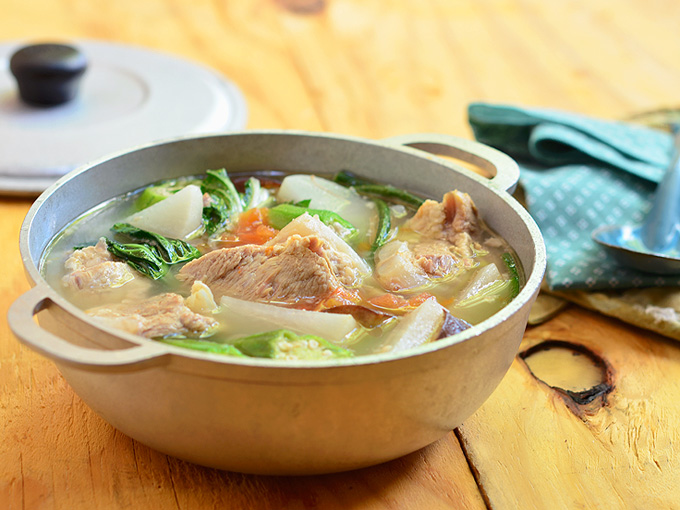It’s the month of June and with it comes the start of the rainy season. If you’ve just started dreaming of the warm summer days, you are not alone. Lately, I have this big craving for one of the most popular Filipino classic comfort food, Sinigang. Sinigang is a classic Filipino stew characterised by its sour and savoury flavour most often associated with tamarind.
Growing up, I’ve tried many variations ranging from pork, fish, shrimp and beef cooked by my mother and my grandmother. I’ve also tried various kinds of sour base for the soup like tamarind, taro, guava and just recently, purple yam. Over the years, Sinigang has evolved in to a complex and modern dish and today, we are going to explore my own personal favourites.
Sinigang na Tadyang ng Baka
For some of you who may not be familiar with this term, tadyang means ribs. This beef spare ribs version of Sinigang is not very common. In fact, it’s fairly new to my ears. This is also the first time I’ve tried this, thanks to the chef of Cafe de Bonifacio.
What’s in it?
This is not your ordinary Sinigang. The sour base is from real and fresh tamarind broth. The beef is slow-cooked to really bring out the meat’s natural flavours. Spiced up with fresh bay leaves, served with the usual Sinigang vegetables like string beans, aubergine and fresh tomato.
What’s the highlight?
The beef, I would say is the best part of this dish. You can savour the meat’s most natural flavours and the beef is very tender. There is a hint of spiciness but it’s very mild. The vegetables are cooked perfectly – not under-cooked and certainly not over-cooked. The green chili adds a mild hint of spiciness.
What’s the secret?
The beef is slow-cooked to about eight to ten hours on low heat. In many restaurants, beef is usually pressure-cooked to save time, compromising the quality. This one is the real deal.
Why we love it?
Unlike many Filipino restaurants that use powdered broth, Cafe de Bonifacio’s broth is entirely home-made with real beef bones. I would be happily just have the broth on its own! The chef emphasised that he wants to present something traditional in this modern culinary age, but unique for his Pinoy customers.
Sinigang na Bangus
Bangus, white fish loved by many locals, is cooked in many different ways. Some like it seasoned and grilled, some like it fried and some like it stewed. Like this famous Sinigang na Bangus.
What’s in it?
If you love your Sinigang as sour and as flavorful as it’s meant to be, Fely J’s Sinigang is the answer. They will serve you with a heavy, filling bowlful bangus belly simmering in a home-cooked style sour soup with your choice of tamarind or guava-base.
What’s the highlight?
The soup! Definitely the soup. It’s just as sour and delicious as it’s meant to be. The fish is cooked perfectly and it has no fishy aftertaste. It’s served with aubergine, kangkong (water spinach), gumbo and string beans.
What’s the secret?
Fely J makes their very own real tamarind broth using only the finest and freshest tamarind. The vegetables are all fresh and they never pre-cook any of them.
Why we love it?
This boneless fish belly makes it easy to fully enjoy the dish without having to worry about the bones getting stuck down your throat.
Sinigang na Corned Beef
This dish is similar to how the Beef Sinigang is made. But this one is much easier and quicker to make because corned beef is usually pre-cooked and canned. Sentro 1771’s best seller, Sinigang na Corned Beef is my favourite beef stew taken to the next level.
What’s in it?
It’s made with natural beef broth and real tamarind broth, served with taro, kangkong, gumbo, aubergine and a generous amount of corned beef.
What’s the highlight?
Obviously, it’s the corned beef. The most satisfying part is when the soup, the meat and the vegetables meet a spoonful of rice. Yes, it’s the only way to enjoy a super delicious Sinigang dish.
What’s the secret?
The secret is the salt-cured beef short ribs served in Sinigang broth prepared to your taste. Yes, they ask you for the level of sourness you like. You can choose from mild, medium or strong. The result of which is a lightly sour-salty-beefy stew.
Why we love it?
The tender and flavourful meat is not over-powered by the sour broth. It’s balanced by the taro and other vegetables that come with it, and they always serve it hot.
Pork Sinigang sa Ube
Now this is all new to me. It’s a mystery. How can ube be a sour base to this traditional sour stew? The talented and creative Capampangan chefs from Abe let us in on a little secret.
What’s in it?
Unlike the usual tamarind Sinigang, this ube version has a thick soup base and the purple colour adds more character to the dish. It’s served with pork, chili, aubergine, kangkong, onion and gumbo.
What’s the highlight?
The mildly sweet, thick, purple soup base is an entirely new Sinigang experience for me. I have never tried anything like it before.
What’s the secret?
The chef creates a separate sour base which is made of real and natural sour fruit (sorry, we can’t mention what it is). The pork is tenderised in this sour broth and the purple yam is added before the meat is completely cooked.
Why we like it?
It’s not your ordinary pork Sinigang. Sour, yet mildly sweet and spicy because of the green chili. It’s est enjoyed with rice because of its thick soup.
Born and raised in a multi-cultural environment and a firm believer that the best way to learn is to travel the world. He enjoys hiking and outdoor bootcamp. His passion for arts, writing, food and business administration lead him to be foodpanda’s Senior Marketing Manager in Hong Kong and in the Philippines.
